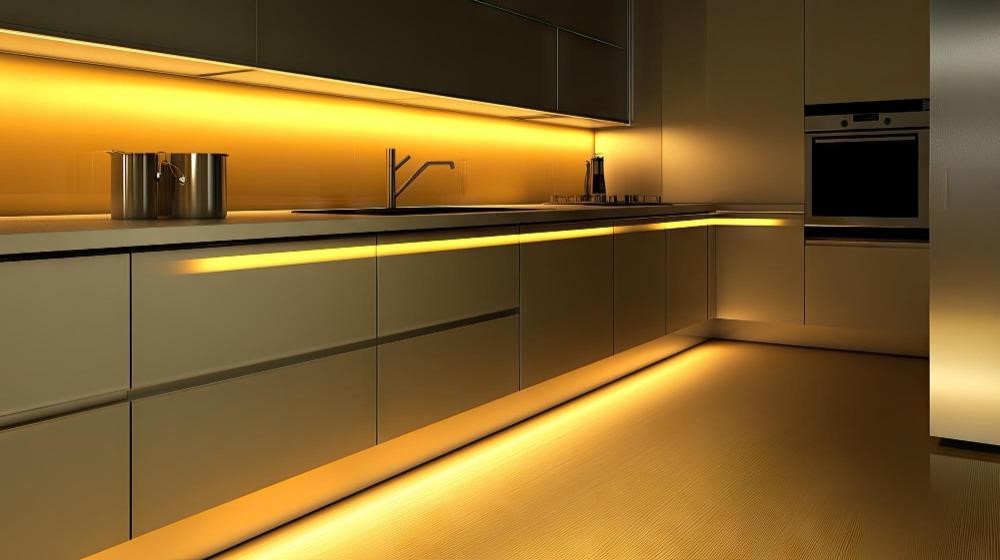
Does your kitchen feel dim even with the overhead lights on? Are shadows making food prep trickier than it needs to be? You’re not alone. Many kitchens suffer from inadequate task lighting, especially beneath cabinets where most of the action happens. This is precisely where kitchen under counter lights step in, transforming your workspace from shadowy to spectacular. They offer focused illumination right where you need it – on your countertops.
Imagine chopping vegetables without squinting or reading recipes easily without straining your eyes. Good under-cabinet lighting isn’t just a luxury; it’s a practical necessity for a functional kitchen. It eliminates annoying shadows cast by upper cabinets and your own body, creating a safer and more efficient cooking environment. Beyond pure function, these lights add a layer of warmth and sophistication, highlighting your backsplash and making the entire kitchen feel more inviting. For homeowners and contractors alike, understanding the impact of well-placed kitchen under counter lights is key to creating a truly functional and appealing kitchen design. Could your kitchen benefit from this simple yet effective upgrade?
Decoding Your Options: Types of Under Counter Fixtures
Choosing the right type of light fixture is crucial for achieving the desired effect. Gone are the days of bulky, energy-guzzling fluorescent tubes. Today’s market offers sleek, efficient, and versatile options. Let’s look at the most popular choices:
- LED Tape/Strip Lights: These are incredibly popular for good reason. Flexible strips lined with small Light Emitting Diodes (LEDs) offer smooth, even illumination across the entire counter length. They are energy-efficient, long-lasting, and often come in customizable lengths and various color temperatures. Installation is typically straightforward, often involving an adhesive backing. Their low profile makes them virtually invisible once installed. Many LED strip options are also dimmable, allowing you to adjust the brightness for tasks or ambiance.
- LED Puck Lights: Small, round, and discreet, puck lights provide focused pools of light. They work well if you want to highlight specific areas or prefer a scalloped light effect on the backsplash rather than a continuous glow. Installation might involve surface mounting or slight recessing. While individual pucks cover less area than strips, placing them strategically (usually 12-24 inches apart) creates effective task lighting. Look for options with good light diffusion to avoid harsh spots.
- Linear Bar Lights: These are rigid fixtures, often slimmer than older fluorescent models but wider than LED tape. They provide consistent, bright light and are very durable. Available in various lengths, they can be linked together for longer counter runs. Installation is usually simple, involving mounting clips screwed into the underside of the cabinet. They offer a robust solution, favored in both residential and commercial settings for their reliability.
Consider the look you want and the ease of installation when making your choice. Do you prefer a seamless line of light or distinct pools? How comfortable are you with the wiring involved for each type?
Powering Up: Hardwired, Plug-In, or Battery?
How your kitchen under counter lights receive power significantly impacts installation and aesthetics.
- Hardwired: This method offers the cleanest look, with all wiring hidden behind walls and directly connected to your home’s electrical system. It typically requires an electrician, especially if new wiring runs are needed, making it a preferred choice during new builds or major renovations. Hardwired systems are often controlled by a wall switch, sometimes integrated with the main kitchen lighting, and allow for easy dimming capabilities. This is often the most reliable and integrated solution, favored by contractors for a professional finish.
- Plug-In: A more DIY-friendly approach involves fixtures that plug directly into a standard wall outlet. Installation is much simpler – mount the lights and run the cord to the nearest socket. The main drawback is the visible cord, which might require creative solutions (like cord covers or strategic placement) to conceal. Some plug-in kits offer linkable fixtures, reducing the number of outlets needed. This is a great option for retrofitting existing kitchens without major electrical work.
- Battery-Operated: For maximum simplicity and installation ease, battery-powered lights (usually LED pucks or small bars) are an option. They stick or screw into place without any wiring. However, they are typically less bright than wired options and require regular battery changes or recharging, making them best suited for small areas or accent lighting rather than primary task illumination. Motion-activated versions can be useful inside cabinets or pantries.
Evaluate your budget, DIY skills, and desired aesthetic when selecting the power source. For a seamless look, hardwired is often best, while plug-in offers a balance of performance and ease.

Getting the Glow Right: Brightness and Color Temperature
Simply installing lights isn’t enough; they need to provide the right kind of light. Two key factors determine this: brightness (measured in lumens) and color temperature (measured in Kelvin).
- Brightness (Lumens): For task lighting over kitchen counters, you need sufficient brightness. Aim for fixtures that provide around 250-500 lumens per linear foot. Too dim, and you defeat the purpose; too bright, and it can cause glare. Dimmable kitchen under counter lights are highly recommended, allowing you to adjust the intensity based on the activity – brighter for chopping, softer for ambiance.
- Color Temperature (Kelvin): This describes the appearance of the light, from warm (yellowish) to cool (bluish).
- Warm White (2700K-3000K): Creates a cozy, inviting atmosphere, similar to incandescent bulbs. Good for general ambiance but can sometimes make colors appear slightly yellow.
- Neutral/Natural White (3500K-4000K): A balanced white light that renders colors accurately. Excellent for task lighting in kitchens as it provides clarity without being too harsh or clinical. This is often the preferred range for food prep areas.
- Cool White/Daylight (4500K+): A crisp, bluish light that can feel energetic but sometimes sterile or harsh in a home kitchen environment. Better suited for commercial or utility spaces.
For most kitchens, a neutral white (around 3500K-4000K) offers the best balance for task performance and visual comfort. Always check the lumen output and Kelvin rating before purchasing.
Placement Perfection: Installing Your Lights Effectively
Where you position your kitchen under counter lights impacts their effectiveness. Placing them too far back can illuminate the backsplash more than the counter, while placing them too far forward might cause glare or make the fixtures visible.
The general recommendation is to mount the lights near the front edge of the upper cabinets, facing straight down or slightly angled towards the backsplash. This directs the light onto the middle and front of the countertop where most tasks occur, minimizing shadows and glare off shiny surfaces.
- Linear Fixtures (Strips/Bars): Aim for continuous runs or place bars end-to-end for even lighting. Center them under the cabinet depth or slightly forward.
- Puck Lights: Space them evenly, typically 12-24 inches apart, depending on the beam angle and desired brightness. Center them under the cabinet.
Consider cabinet structure and any light rails (a small trim piece under the cabinet face) that might help conceal fixtures. Always follow the manufacturer’s specific installation instructions. For hardwired systems, consulting a qualified electrician is essential for safety and code compliance.

Finding Quality and Support You Can Trust
Investing in good quality lighting ensures longevity, energy efficiency, and reliable performance. When selecting your fixtures, consider the reputation of the supplier. Look for companies that stand behind their products. For instance, suppliers known for excellent customer service can be invaluable, especially if you have questions during selection or installation. Market competitive pricing is important, but it shouldn’t come at the expense of quality. Reading reviews and checking warranty information is always wise.
Companies like AQ Lighting Group often provide detailed product specifications and support, helping customers choose the right solution. Easy return policies also offer peace of mind, ensuring you’re satisfied with your purchase. Choosing a trusted source ensures you get reliable kitchen under counter lights that will brighten your kitchen for years. Remember, good lighting is an investment in your home’s functionality and appeal. Why settle for less when reliable options are available?
FAQs
Are under cabinet kitchen lights worth it? Absolutely. They significantly improve task visibility on countertops, reduce shadows, enhance kitchen safety during food prep, and add ambiance and perceived value to your home. They are a highly functional and aesthetic upgrade.
- What type of under counter lighting is best for kitchens?
LEDs (strips, bars, or pucks) are generally the best choice due to their energy efficiency, long lifespan, low heat output, and excellent light quality. LED strips offer even illumination, while pucks provide focused light. The “best” type depends on your specific needs and aesthetic preferences. - Should under cabinet lighting be warm or cool?
For kitchens, a Neutral/Natural White (3500K-4000K) is often recommended. It provides clear, accurate color rendering ideal for tasks like chopping and cooking, without being overly harsh like cool white (4500K+) or too yellow like warm white (2700K-3000K). - Where should kitchen under counter lights be placed?
Typically, they should be mounted near the front edge of the upper cabinets, pointing downwards or slightly back towards the backsplash. This placement ensures the light falls directly onto the main work surface, minimizing shadows and glare. - How many lumens do I need for kitchen under counter lighting?
Aim for approximately 250-500 lumens per linear foot of counter space for effective task lighting. Using dimmable lights allows you to adjust the brightness level as needed for different activities or moods.
